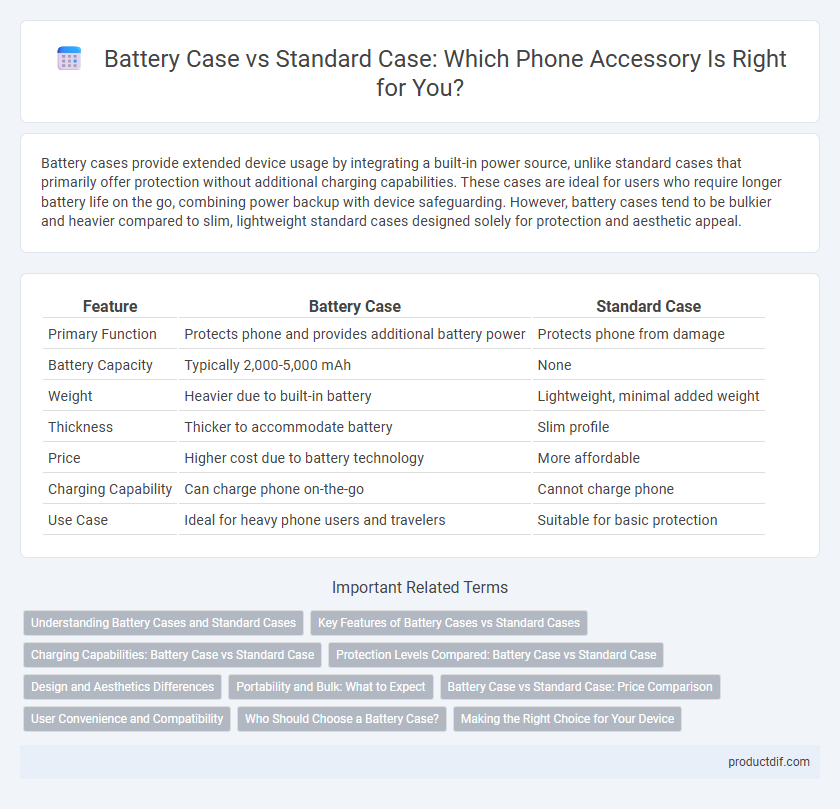Battery cases provide extended device usage by integrating a built-in power source, unlike standard cases that primarily offer protection without additional charging capabilities. These cases are ideal for users who require longer battery life on the go, combining power backup with device safeguarding. However, battery cases tend to be bulkier and heavier compared to slim, lightweight standard cases designed solely for protection and aesthetic appeal.
Table of Comparison
| Feature | Battery Case | Standard Case |
|---|---|---|
| Primary Function | Protects phone and provides additional battery power | Protects phone from damage |
| Battery Capacity | Typically 2,000-5,000 mAh | None |
| Weight | Heavier due to built-in battery | Lightweight, minimal added weight |
| Thickness | Thicker to accommodate battery | Slim profile |
| Price | Higher cost due to battery technology | More affordable |
| Charging Capability | Can charge phone on-the-go | Cannot charge phone |
| Use Case | Ideal for heavy phone users and travelers | Suitable for basic protection |
Understanding Battery Cases and Standard Cases
Battery cases integrate an internal power source to extend smartphone usage by providing additional charge, unlike standard cases which primarily offer protection and style without any charging functionality. The capacity of battery cases often ranges from 3000mAh to 6000mAh, effectively doubling or tripling device battery life during heavy usage. Standard cases focus on materials like silicone, polycarbonate, or leather to safeguard against drops, scratches, and everyday wear without increasing device bulk or weight significantly.
Key Features of Battery Cases vs Standard Cases
Battery cases integrate an internal power source that extends device usage time, unlike standard cases which primarily offer protection without added battery capacity. Key features of battery cases include built-in rechargeable batteries, charging indicators, and pass-through charging capabilities that allow simultaneous device and case charging. Standard cases focus on material durability, shock absorption, and slim form factors without compromising device aesthetics.
Charging Capabilities: Battery Case vs Standard Case
Battery cases offer integrated power cells that extend device usage by providing on-the-go charging, whereas standard cases lack charging capabilities and serve primarily as protective shells. The charging capacity of battery cases varies, typically ranging from 2,000mAh to 5,000mAh, enabling multiple full charges without external power sources. Standard cases depend on separate charging accessories, which may result in slower or less convenient charging compared to the seamless energy boost provided by battery cases.
Protection Levels Compared: Battery Case vs Standard Case
Battery cases offer enhanced protection with reinforced edges and shock-absorbing materials that safeguard devices from drops and impacts, compared to standard cases which primarily provide basic scratch and minor bump protection. The integrated battery pack adds bulk, increasing overall case thickness but allowing for an additional layer of defense against physical damage. Standard cases, while sleeker and lighter, generally lack the robust construction necessary to prevent significant damage during high-impact incidents.
Design and Aesthetics Differences
Battery cases typically feature a bulkier design to accommodate the internal battery, resulting in increased thickness and weight compared to standard cases. Standard cases prioritize sleekness and minimalism, often crafted from lightweight materials like silicone or polycarbonate to enhance the device's aesthetic appeal. The added bulk of battery cases may compromise the phone's slim profile, whereas standard cases preserve the original design and form factor.
Portability and Bulk: What to Expect
Battery cases offer enhanced portability by integrating additional power without the need for separate chargers, but they tend to be bulkier and heavier compared to standard cases. Standard cases prioritize slimness and lightweight design, providing minimal bulk and easier pocket or bag storage. Users prioritizing extended battery life should expect a trade-off with increased size, while those focusing on portability may prefer the sleek profile of standard cases.
Battery Case vs Standard Case: Price Comparison
Battery cases typically cost between $50 and $120, offering integrated power solutions, whereas standard cases range from $10 to $40, primarily providing protection without added battery capacity. The higher price of battery cases reflects advanced technology and convenience, making them an investment for users seeking extended device usage. Standard cases remain cost-effective choices for basic protection without extra functionality.
User Convenience and Compatibility
Battery cases provide enhanced user convenience by combining phone protection with extended battery life, reducing the need to carry separate chargers. Standard cases offer broader compatibility across different phone models due to their minimalist design without integrated power components. Users prioritize battery cases for on-the-go power boosts, while standard cases appeal to those seeking lightweight, versatile protection compatible with various accessories.
Who Should Choose a Battery Case?
A battery case is ideal for heavy smartphone users who require extended battery life throughout the day without access to charging outlets. Professionals, travelers, and outdoor enthusiasts benefit from the integrated power source that provides on-the-go charging while protecting the device. Users needing occasional extra power combined with durable protection should choose a battery case over a standard case.
Making the Right Choice for Your Device
Battery cases offer extended power by integrating an additional battery, ideal for heavy users or long days without charging, while standard cases prioritize lightweight protection and style. Selecting between a battery case and a standard case depends on your device usage patterns and priorities, with factors like battery capacity measured in mAh and the device's compatibility playing crucial roles. Analyzing your daily power needs and the phone model's dimensions ensures you make the right choice, balancing convenience with functionality.
Battery case vs standard case Infographic

 productdif.com
productdif.com